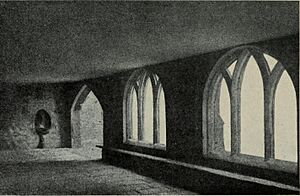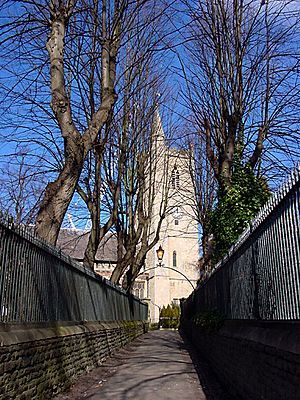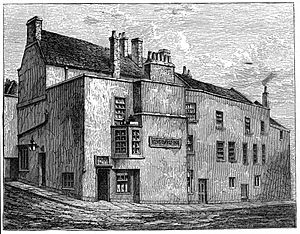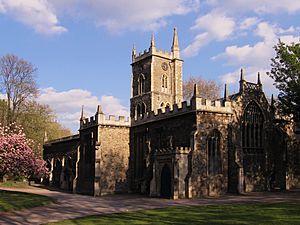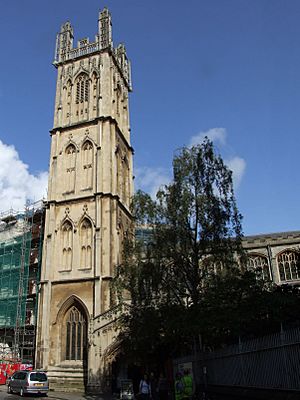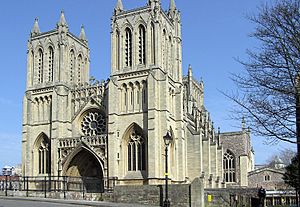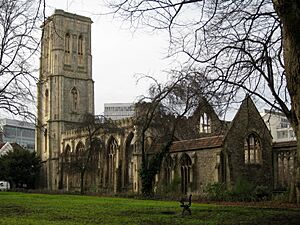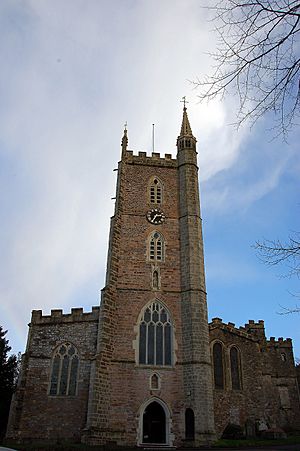List of monastic houses in Bristol facts for kids
Bristol, a historic city in England, was once home to many important religious buildings called monastic houses. These were places where monks, nuns, or friars lived and prayed together. They played a big role in the community, often providing education, healthcare, and charity.
This article explores the different types of monastic houses that existed in Bristol, including abbeys, priories, and friaries. You'll learn about when they were founded and what happened to them over time.
Alien houses are included, as are smaller establishments such as cells and notable monastic granges (particularly those with resident monks), and also camerae of the military orders of monks (Knights Templars and Knights Hospitaller). Monastic hospitals are included where they had the status or function of an abbey, priory, friary or preceptor/commandery.
- Abbreviations and key
| Symbol | Status |
|---|---|
| None | Ruins |
| * | Current monastic function |
| + | Current non-monastic ecclesiastic function (including remains incorporated into later structure) |
| ^ | Current non-ecclesiastic function (including remains incorporated into later structure) or redundant intact structure |
| $ | Remains limited to earthworks etc. |
| # | No identifiable trace of the monastic foundation remains |
| ~ | Exact site of monastic foundation unknown |
| ≈ | Identification ambiguous or confused |
Locations with names in italics indicate possible duplication (misidentification with another location) or non-existent foundations (either erroneous reference or proposed foundation never implemented) or ecclesiastical establishments with a monastic name but lacking actual monastic connection.
| EH | English Heritage |
| LT | Landmark Trust |
| NT | National Trust |
Monastic Houses in Bristol's History
Friaries: Homes for Friars
Friaries were homes for groups of religious men called friars. Unlike monks who often lived in isolated monasteries, friars usually lived in towns and cities. They focused on helping people in the community and often begged for their food and supplies.
Austin Friars
The Austin Friars were a group of Augustinian Friars. They set up their house in Bristol in 1313. This friary was also used as a place for students from other countries to stay and study. It closed down in 1538.
Blackfriars
The Blackfriars were Dominican Friars, known for their black cloaks. Their friary was founded around 1227 or 1228. It closed in 1528 or 1538. The site has been used for different purposes over the years, including a Quaker meeting house and now a restaurant.
Eremites Friars
The Bristol Eremites Friars also had a house in the city. Not much is known about their specific history in Bristol, but they were another type of friar community.
Friars of the Sack
The Friars of the Sack were a smaller group of friars. They were established in Bristol before 1266. This friary didn't last very long, closing down after 1286. The friars had left by 1322, though their church was still used for a while.
Greyfriars
The Greyfriars were Franciscan Friars Minor, named for their grey robes. Their house was founded between 1230 and 1234. It was dedicated to Saint Francis. The friary closed in 1538, and its land was given to the Mayor and citizens of Bristol around 1541.
Whitefriars
The Whitefriars were Carmelite Friars. They were founded in Bristol between 1256 and 1267 by Edward, who later became King Edward I. This friary also closed in 1538. Today, the site where it once stood is occupied by the Colston Hall.
Priories and Abbeys: Monks and Nuns
Priories and abbeys were larger religious houses where monks or nuns lived under strict rules. Abbeys were usually bigger and more important than priories.
St James's Priory
St James's Priory was home to Benedictine monks. It was founded in the 1120s by Robert, Earl of Gloucester, who was the son of King Henry I. The priory closed in 1539. Part of the church has been used by the local community since 1374. Since 1996, it has been cared for by the Little Brothers of Nazareth.
St Mary Magdalen Nunnery
St Mary Magdalen Nunnery was a house for Augustinian Canonesses (nuns). It was founded in 1173. The nunnery closed in 1536. Today, the King David Inn stands on the site where the nunnery once was.
St Philip's Priory
Bristol — St Philip's Priory was another Benedictine monk community. It was founded around 900 AD. The church of Saint Philip and Saint Jacob still stands today.
St Stephen's Priory
Bristol — St Stephen's Priory was also a Benedictine monk house. It was connected to the famous Glastonbury Abbey in Somerset.
Bristol Cathedral Abbey
Bristol Cathedral Abbey, also known as St Augustine's Abbey, was founded by Augustinian Canons Regular between 1140 and 1142. It closed as an abbey in 1539. However, it was then reopened as a cathedral in 1542 and is still an important church today, known as The Cathedral Church of the Holy and Undivided Trinity.
Bristol Preceptory
The Bristol Preceptory was a house for the Knights Templar. These were a military-religious order. The church built on the site of their original church is now in ruins.
Westbury Priory
Westbury Priory has a long history. It started as a Saxon minster (an early church community) in 716 AD. It was likely destroyed by Viking raids. Later, it was refounded several times as a Benedictine priory for monks. By 1194, it became a college of secular priests. Today, a local church stands on the site.
See also


